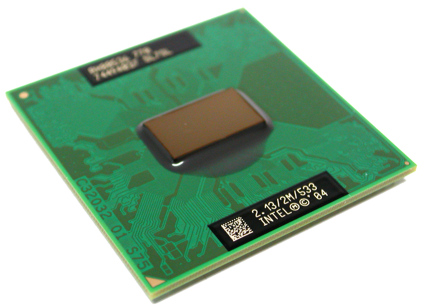Dothan Over Netburst: Is The Pentium 4 A Dead End?
The Intel Pentium M Processor
The box of one of our Pentium M review CPUs with lots of detailed information.
Although the Pentium M is officially available through the retail channel as a so-called "boxed" version, it's not exactly a "take away" part. In other words, retailers usually have to order supplies, since customers that buy an original notebook processor separately are a distinct minority.
Currently, the prices of Pentium M processors in the market place range from $190 to $650. The Celeron M, with its simpler design, costs between $85 and $150. However, in addition to offering lower performance, the Celeron M also comes with pared down energy management features.
What Sets It Apart From The Pentium 4
A Pentium M 770 processor rated at 2.13 GHz. Unlike the Pentium 4, the die itself is not covered by a heat spreader, needed to allow a better transfer of heat to the cooler while simultaneously protecting it from mechanical damage.
As we mentioned before, Intel quotes the maximum thermal dissipation of the 2.13 GHz model as 27 Watts. Another difference compared to the Pentium 4 is the lack of an integrated heat spreader (IHS), a small metal plate that sits directly on top of the chip's die. Together with a small amount of thermal compound, the heat spreader ensures an optimized heat transfer to the heatsink, and protects the core from mechanical damage. Since a Pentium M isn't usually replaced by the end user, the heat spreader is not included. Besides, it would only add to the overall height of the CPU / cooler combination.
Intel has incorporated a feature called SpeedStep into the processor, allowing it to reduce its clock speed on the fly when it is sitting idle. When more performance is required, the clock speed is automatically increased again. Depending on the individual model, the minimum frequency lies between 600 and 800 MHz. AMD is taking a similar approach with its "Cool & Quiet" feature, although C&Q is also enabled on desktop processors. Only the newest Pentium 4 models in the 600 series offer a similar feature, and they only support downclocking to 2.8 GHz. Not much, but at least it's a start. The Celeron M, meanwhile, doesn't offer any support at all for SpeedStep.
SpeedStep also has another convenient side effect. Since the processor has to vary its internal clock speed, the necessary multipliers can be freely selected, providing the mainboard's BIOS features a suitable set of options. For overclockers, this can be an essential option.
Get Tom's Hardware's best news and in-depth reviews, straight to your inbox.
The final difference between the two processors is that they use different sockets. While the Pentium M comes with 479 pins, the older Pentium 4 models used a 478 pin socket. The fact that the number of pins is nearly identical seems to be a good indication that outwardly, these two chips operate in a similar manner.
For more information on the two architectures we recommend the following articles:
Current page: The Intel Pentium M Processor
Prev Page Pentium M: Taking Back The Desktop? Next Page What It Shares With The Pentium 4
Patrick Schmid was the editor-in-chief for Tom's Hardware from 2005 to 2006. He wrote numerous articles on a wide range of hardware topics, including storage, CPUs, and system builds.


